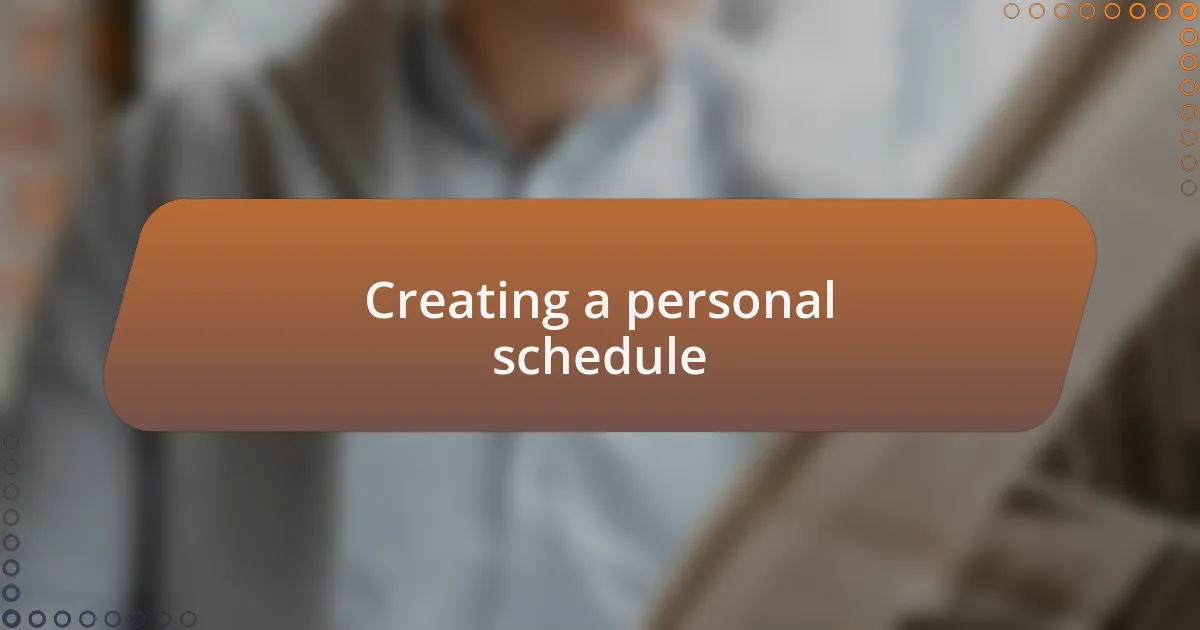Key takeaways:
- Effective time management involves prioritization, breaking tasks into manageable blocks, and learning to say no to distractions.
- Utilizing visual tools like calendars and setting clear, actionable goals can significantly enhance productivity.
- Flexibility in scheduling is crucial; adapting to unexpected changes can lead to maintaining balance between commitments.
- Collaboration with peers for support and accountability can optimize both training and academic success, fostering a sense of community.

Understanding time management
Time management is more than just a skill; it’s a way of life. I remember a time when I juggled both training for a tournament and preparing for exams. I found myself wondering, how could I maximize my limited hours without compromising on either my performance or my grades?
Breaking my day into blocks allowed me to see where my time was going. I set specific goals for each block, whether it was focusing on drills or hitting the books. But what truly transformed my approach was realizing that I often allowed distractions to nibble away at my time. Have you ever felt like you’d been working for hours only to discover you accomplished very little?
What’s been enlightening is the importance of saying no. At one point, I was tempted to join another sports team, but I quickly realized that it would infringe on my study time. Reflecting on this, I understood that prioritization is the cornerstone of effective time management. It’s not just about doing more; it’s about doing what truly matters.

Strategies for effective time allocation
One effective strategy I adopted was the use of a visual calendar. I remember when I first started mapping out my week, color-coding blocks for training, classes, and downtime. This way, I could immediately see when my schedule was dense and when I had breathing room. Have you ever felt overwhelmed, only to realize you had more free time than you thought? By visually organizing my day, I not only maximized productivity but also created moments for relaxation, making the rigorous training feel more manageable.
Another approach that worked wonders for me was integrating short, focused study sessions into my training schedule. I once experimented with 25-minute study sprints between drills, and to my surprise, I found that I retained information better. It’s as if I had taken the intensity from sports and applied it to studying—why not give that strategy a try? This technique helped me stay engaged and motivated, proving that you don’t need long hours to be effective; you just need intention.
Finally, I learned the value of reflection and adjustment. At the end of each week, I took time to evaluate what strategies worked and what didn’t. Have you ever hit a wall and needed to reassess your plan? I recall one particular week where my training yielded little progress because I’d overloaded myself. By reflecting on my experiences, I adjusted my time allocation, allowing me to balance both sports and academics more effectively, ultimately leading to improved performance in both areas.

Setting clear priorities in activities
Setting clear priorities in activities is crucial for managing sports and personal commitments. I distinctly remember a time early in my athletic career when I felt torn between a big game and a family event. I had to ask myself, what truly mattered at that moment? Prioritizing my commitments meant giving my team the focus they deserved while ensuring my family knew I valued their support. Learning to say “no” to less urgent activities created a more balanced experience for me.
Another memorable instance happened during exam week when my instincts told me to cram study hours instead of resting. I quickly realized that prioritizing sleep over an extra study session would enhance my performance in both sports and academics. It was a game-changer; by acknowledging the importance of rest, I entered competitions feeling alert and ready. Have you ever underestimated the impact of a good night’s sleep? That night, I finally embraced the idea that self-care is not a luxury; it’s a necessity.
Over time, I started to categorize my activities by urgency and importance. For example, when preparing for a major competition, I’d identify critical training sessions and align my academic responsibilities accordingly. I found that visual cues, like sticky notes marking deadlines, helped me clarify what needed my attention first. Isn’t it fascinating how simply organizing tasks can reduce anxiety? This conscious effort in setting priorities allowed me the freedom to pursue my passions without sacrificing my personal life or well-being.

Creating a personal schedule
Creating a personal schedule has been a game-changer in my journey. I remember a particularly hectic month when I was juggling training for a marathon while preparing for a crucial presentation at school. I sat down one evening with my planner and mapped out my days like a puzzle, slotting in training sessions, study hours, and even downtime. This simple act of planning helped me visualize my weeks and ensured that I made the most of each moment. Do you ever feel overwhelmed by your commitments? A personal schedule can make a world of difference.
I learned that being flexible is just as important as sticking to a schedule. One day, I had planned an intense workout, but a friend invited me to a surprise gathering. Instead of rigidly adhering to my schedule, I assessed the situation and realized the value of nurturing friendships and taking a break. I shifted my workout to another time and enjoyed a relaxed evening, which ultimately brought a refreshing perspective to my training. Isn’t it interesting how a little flexibility can lead to unexpected joy?
In my experience, adding specific goals to my schedule transformed my approach to managing time. Instead of simply noting “study for exam,” I would break it down into smaller, actionable steps like “review chapter one for 30 minutes.” This way, accomplishments felt more tangible, and I could celebrate those small victories along the way. Have you tried breaking your tasks down like this? It can be incredibly rewarding to see progress, and it kept me motivated, allowing me to balance sports and my personal life effectively.

Overcoming common time management challenges
Sometimes, time management challenges arise unexpectedly, disrupting our carefully crafted schedules. I remember a week when my usual training routine was thrown off by a family commitment that I simply couldn’t miss. Instead of dwelling on the disruption, I re-evaluated my priorities and found pockets of time in my day where I could squeeze in shorter workouts. Have you ever had to pivot like that? It taught me that adaptability is key in maintaining balance.
As I navigated my journey, I discovered that distractions were a significant barrier to effective time management. I recall attempting to study for a big exam while my phone notifications buzzed incessantly. Eventually, I set aside designated “focus time,” where I silenced my phone and pledged to concentrate solely on my tasks. I found it fascinating how removing those distractions, even temporarily, vastly improved my productivity. Have you noticed how much easier it is to stay on track when you eliminate interruptions?
One of the common challenges I faced was the tendency to overcommit myself. I often felt torn between accepting invitations for social events and sticking to my training regimen. One time, I had to choose between attending a friend’s birthday party or a crucial practice session. I chose to attend the party but made a pact with myself to wake up early for an extra training session the next day. That night not only deepened my friendships but also taught me that it’s okay to prioritize well-being without sacrificing your passions. How do you handle competing commitments? Balancing priorities is an ongoing journey, but it’s one worth taking.

Personal anecdotes of success
Despite the challenges, I’ve celebrated moments that turned into milestones. I recall a particular season when I decided to reallocate time from my social life for an upcoming competition. Each early morning, I felt a mix of exhaustion and excitement as I committed to my training. The culmination of those efforts was evident when I stepped onto the podium, realizing that my sacrifices had translated into tangible success. Has a moment like that ever made you reflect on your choices?
Another success story etched in my memory is when I collaborated with teammates to create a study schedule that harmonized our training and academic needs. By openly discussing our goals, we devised a plan that allowed us to support each other. This not only fostered accountability but also strengthened our bond as a team. I often wonder how aligning shared ambitions can enhance personal success.
Then, there was that unforgettable time when I stood at the finish line, feeling an overwhelming rush of accomplishment after completing my first marathon. Balancing my sports commitments with personal growth had been a daunting journey, but crossing that finish line was a profound reminder that hard work pays off. I couldn’t help but reflect on how these experiences shaped my character and fueled my passion for both sports and life. Have you ever had a moment where everything just clicked for you?